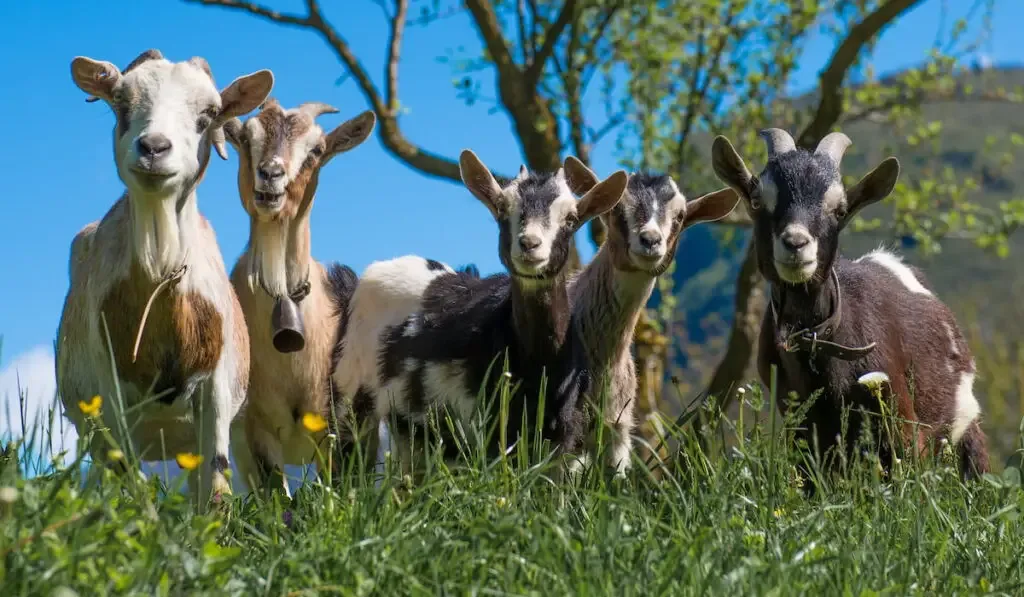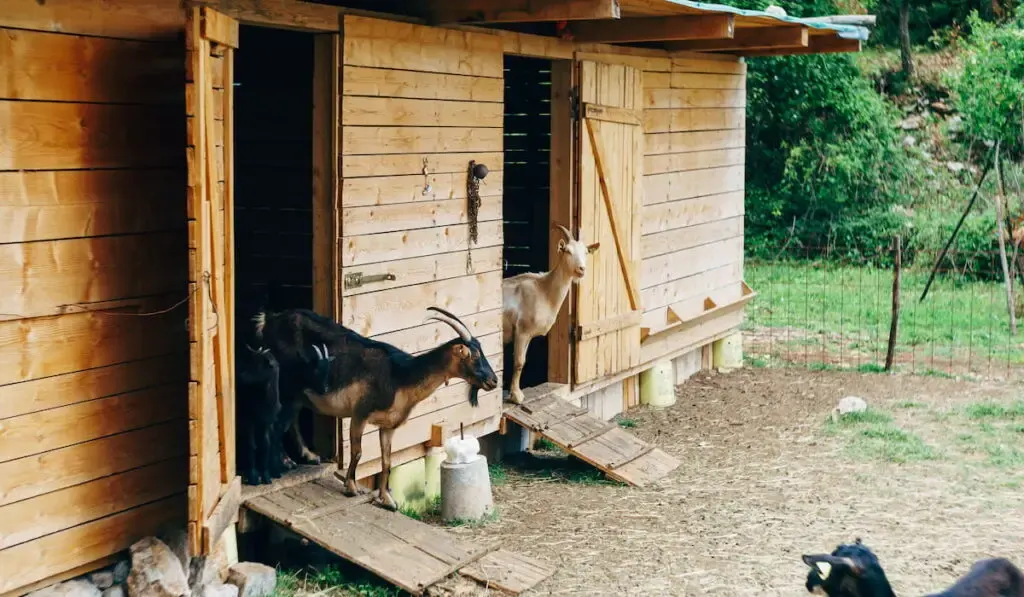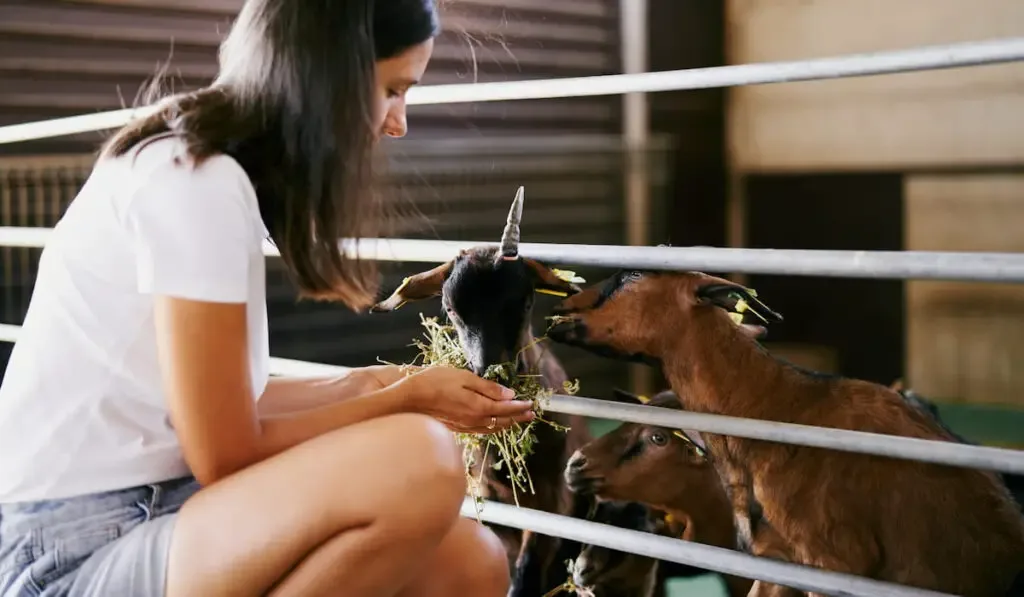Goats are definitely one of the favorite farm animals that breeders or homesteaders raise for different purposes. These small ruminants can be found all over the world, providing people with their delicious meat, nutritious milk, and even being kept as family pets.
There is no right or wrong choice here. You can definitely raise goats for all these purposes. The only question is: how you can successfully raise them without making expensive mistakes, even as a beginner?
This ultimate guide to raising goats will cover every important detail about selecting a suitable breed, what you need to prepare, the do’s and don’ts, and the challenges that you have to face. Without further ado, let’s begin.

Selecting The Best Goat Breed
As with raising other animals, you want to have the best breed that caters to your goals and needs. There are many breeds of goat that you can choose and you have to be specific with your purpose of raising them.
Do you want to raise these ruminants for meat or milk? Are you the one who prefers getting the best of both? Do you also love to keep these animals as family pets?
Depending on their purpose, different breeds offer different benefits to their owners. Doing some background checks and research on each goat category is extremely important so that you know which breed will benefit you the most.
Here are some of the domestic goat breeds that you can find in the United States and other parts of North America.
| Breeds | Height | Weight | Purposes |
| American Pygmy | 4.0 – 5.0 ft | 55 – 88 lbs | Meat |
| American LaMancha | 2.3 – 2.5 ft | 130 – 160 lbs | Meat and milk |
| Alpine | 2.8 – 3.3 ft | 135 – 170 lbs | Milk |
| Angora | 3.0 – 4.0 ft | 70 – 225 lbs | Meat |
| Boer | 2.3 – 2.5 ft | 198 – 297 lbs | Meat |
| Guernsey | 2.2 – 2.3 ft | 120 – 200 lbs | Milk |
| Kiko | 2.2 – 3.1 ft | 100 – 300 lbs | Meat and milk |
| Kinder | 2.2 – 2.3 ft | 115 – 150 lbs | Meat and milk |
| Myotonic | 1.4 – 2.1 ft | 60 – 174 lbs | Meat |
| Nigerian Dwarf | 1.6 – 2.0 ft | 60 – 80 lbs | Meat and milk |
| Nubian | 2.5 – 2.9 ft | 135 – 175 lbs | Meat and milk |
| Oberhasli | 2.3 – 2.5 ft | 120 – 150 lbs | Milk |
| Pygora | 1.5 – 1.9 ft | 64 – 95 lbs | Milk |
| Saanen | 2.2 – 2.5 ft | 150 – 170 lbs | Milk |
| Sable | 2.5 – 2.7 ft | 145 – 187 lbs | Milk |
| Savanna | 1.6 – 2.1 ft | 125 – 250 lbs | Meat |
| Spanish | 1.4 – 2.1 ft | 100 – 250 lbs | Meat |
| Toggenburg | 2.6 – 3.0 ft | 149 – 200 lbs | Meat and milk |
Aside from meat and milk, some people would raise certain breeds that are categorized as fiber goats and pack goats. Fiber goats are raised for their mohair that can be commercially produced into luxury fibers and high-end clothing materials. Some of the popular fiber goats are Angora, Pygora, and Cashmere goats.
On the other hand, pack goats are used for heavy work. Due to their lean and strong bodies, pack goats are trained by breeders to carry a load when traveling up the mountain or during a trip into the wilderness.
Researchers, travelers, and scientists will also use pack goats to carry their equipment. They are much more nimble, cheap, and are much easier to handle compared to using workhorses. Some of the common pack goat breeds are Alpine, LaMancha, Saanen, and Toggenburg.
Although it is wise for you to start with a few goats, you should purchase and raise at least two goats. This is because goats can become lonely and sad if they have no companion. So, a doe and wether or two does would be the best combination for starter goats.
Finally, the cost of a goat could vary depending on their breed, age, sex, and the time of the year they are being purchased. For a goat that doesn’t fall in a rare or heritage breed, they generally cost between $85 to $200.
When purchasing goats, it is always better to buy from private professional breeders or amateur farmers rather than in auctions. This is because when you are dealing with private sellers, you will have more time to inspect and look at the goats. Furthermore, you can ask for health records or lineage documentation to verify the authenticity and purity of the goats.

Building a Goat Shelter
Before you bring your goats home, there are a few things that you should prepare. One of them would be a large amount of space on your backyard or property. Goats need a space to exercise, run, browse, and mingle. Ideally, you can prepare at least 10 to 15 feet of space per goat.
This space should give enough room for them to roam, walk, and run freely. Goats can’t live healthily inside tight and confined spaces. They become stressed, unhappy, or worse, fall sick due to the diseases that can easily spread in crowded places.
The space you should provide is totally dependent on the breed you choose. The bigger they are, the greater space they need per individual.
Goats generally don’t need a fancy shelter. Depending on the size of the herd, they can simply live in a three-sided structure that covers them from adverse weather. If you don’t have enough capital to splurge, a simple barn that could accommodate all your goats is more than enough.
You can build different types of goat shelters from recycled and cheap materials. These include:
· Wood Frame Shelter
This type of shelter is the cheapest and simplest structure that can be built using metal or regular shingle roofing. One side should be partially enclosed and another should be opened with a small opening or door for ventilation purposes. If the site has proper drainage, you don’t build a floor for this kind of shelter. As long as the ground is always dry, the bedding can be hay or straw.
· Used Pallets Shelter
Used pallets can be used to build a simple three-sided shelter. These free pallets can easily be found in factories, farm stores, building sites, or large farms. Then, you have to buy two-by-fours, plywood, and roofing materials. The floor should be made from wooden materials that can insulate the shelter from a sudden temperature change.
· Tarp Quonset Hut
A tarp Quonset hut works best for meat goats or farmers who live in a milder climate. This structure is open on both ends, providing good ventilation inside the hut. Moreover, the hut itself is built from metal panels that can withstand harsh weather, heavy snow, and strong wind.
· Dog Run
If you are raising a few small to medium-sized goats, then, a dog run could accommodate these animals. However, a dog run should only be used for a short period of time. Goats need a proper space to live in and a dog run or pen isn’t big enough to shelter a large herd, especially when the does give birth to a few kids.
Additionally, you should also build fences around the goat’s shelter. Goats are able to jump and knock over fences when they want to. This is why a strong fence is crucial to keep these animals inside their designated areas, thus preventing any attempt to escape or worse, trespassing and causing damage to your neighbors’ lawn or backyard.
There are many fence options that you can choose ranging from barbed or welded wire fences, stock panels, rail fences, chain-link fences, and many more. Ideally, a smooth, high-tensile electrified wire fence should be enough to keep the goats from escaping.
This fence should also stand high between 4 and 5 feet tall. Depending on the breed, some taller and larger breeds might need bigger and much higher fences.

Feeding Your Goats
It is no surprise that we always perceive goats as plant-based eaters that eat every green plant. But this is far from the truth. Goats can be picky, and at times, they should eat different types of feed so they remain healthy.
Aside from natural forages like shrubs, trees, and foliages, hay is also beneficial to these ruminants. You can feed with them with legume-based hay but alfalfa hay bales, Bermuda hay bales, and a Bermuda-alfalfa blend are also fine.
Aside from traditional hay, you can also feed goats with chaffhaye and grain feed. Chaffhaye is a specific type of alfalfa that is mixed with probiotic culture, Bacillus subtilis, and molasses.
This type of hay is high in nutrients and contains live microorganisms that facilitate healthy digestion and nutrient absorption. Then, grain feed can also be mixed with traditional hay to add more taste and nutrients to the feed.
In the winter, goats tend to eat more due to need more energy for heat and a high metabolism. By adding or increasing the rations of grain feed, breeders are able to provide their goats with more proteins, vitamins, and other nutrients without breaking the bank.
Goats should also have access to mineral blocks or salt blocks that could supplement them with minerals or trace elements that don’t exist in other feed. These mineral blocks can be purchased at any agricultural store for $2 to $5, depending on their size and weight.
Feeding goats with hay is beneficial to their four-chambered stomach. Hay helps in digestion and facilitates the growth of healthy bacteria in the rumen. However, purchasing hay is quite expensive and goats will make quite a mess when they eat hay.
Of course, there is nothing wrong with feeding goats with pellets. They are much cheaper, easy to clean and carry, and don’t produce a lot of waste. But on the downside, pellets can make goats bloated because they can’t be a long-term substitute for the natural fibrous stem that hay or grass provides.
No matter which mix of feed that you give them, the wrong amount of food is detrimental to the growth of your goats. If you don’t feed them enough, they can become irritable and if you overfeed them, they can become lethargic.
The key is to find the right balance, which will depend on the size of each individual goat.
As a general rule of thumb, goats should eat around 10 to 12 percent of their body weight per day.
For instance, if the goat weighs around 20 pounds, then its diet should consist of 32 ounces of feed per day.

Milking The Goats
Owning goats isn’t just about knowing how to raise and feed them properly. If you raise dairy goats, you should take full advantage of the does’ milk. Knowing how to milk your goats will surely separate you from other goat breeders. Not to mention, this life-long skill can be utilized for economic purposes once the herd grows larger.
Even as beginners, you will get a hang of this quicker than you can imagine. Contrary to what you have heard or read on the internet, milking goats is quite easy. But first and foremost, what you need is all the supplies to get started including:
- Milk stand
- Stainless steel bucket
- Udder-washing items
- Teat sanitizing supplies
- Milk filters
- Storage jars
After you have gathered all the supplies, it is time for you to hand-milk the goats. Here’s how:
- Bring the goat onto the milking stand. Use goodies like hay or a mixture of pellets with organic grains to attract the goats. Secure the goat once she gets inside the stanchion.
2. Wash your hands to remove any debris or dirt. If possible, shave the udders to make the milking process easier.
3. Clean the udder and teats thoroughly. You can use warm water, low-pH soap, or udder wipes. Squeeze the teats and wipe the opening slowly.
4. Do one to two squirts on each teat. This step must be done to ensure that the teat’s opening and the milk is free from bacteria. Be sure to examine the milk texture. If there are signs of blood or clumps, then the goat should be checked for mastitis or other serious illnesses.
5. If the milk is clear, then you can continue with the milking process. To milk the goat, grab the teat as high as possible, around a couple of inches into the udder.
6. Squeeze the teat hard using your thumb and index finger. Keep these two fingers tight while bringing your palm and other fingers closer. This will create pressure that will squirt the milk out into the bucket. Avoid any spillage by bringing the bucket closer to the teat. Repeat this process for each teat.
7. Once the udder is empty, slowly massage the front and back of the udder to ensure that there is no milk left. The udder will look wrinkly when it’s empty.

Slaughtering Goats For Meat
Aside from selling your goats to the butcher shop or meat markets, you can also slaughter, skin, and butcher these animals all by yourself, given that you know how to.
Before anything else, you should know that goat meat can be categorized into two types: Cabrito, young goats between one to two months old, and Chevon, which is older goats between 10 to 12 months old. The older goats get, the lower their possibility of being butchered.
This is because the meat of older goats tends to get very smelly and the odor is hard to eradicate. Also, older goats’ meat is not as soft and tender as the meat of younger goats.
Before slaughtering the goat, you will have to knock it unconscious with a blow to its head. Once it passes out, you can slit its throat. Your hands should be strong and steady when slitting the goat’s throat.
Be sure to tie the front and back legs to prevent any sudden movement that could torture the goats. Then, string the goat up and let the blood flow until it dies.
When it comes to skinning the goat, you can begin by cutting around the skin of the back legs and slit it downwards. Then, make a small incision around the anus and cut the skin from the neck back to the tail.
This should be done slowly to avoid puncturing the offal and destroying the texture of the meat. Once you have loosened the skin, you can pull the rest of the skin downwards. Try pulling the skin hard and quick without tearing the meat apart.
Finally, you can empty the cavity by removing all of the organs. Be sure to wash the carcass thoroughly before moving on to the next goat. You can still hang the carcass for the next 24 hours but after that, it should be kept in a fridge or a cold storage box.

Keeping Your Goats Healthy
Raising healthy goats begins with good hygiene and clean environments. Goat feeders and waterers should be cleaned regularly to prevent any contamination that could attract bacteria and other harmful microorganisms.
By using feeders or an elevated trough, you could prevent these animals from feeding on the ground, thus reducing their exposure of getting parasites from manures.
Although there are certain preventive measures that you could take, this doesn’t mean that your livestock is completely free from catching other serious diseases. There are still other illnesses that can infect your goats including:
- Pneumonia
- Parasitic skin infection
- E.coli infection
- Enterotoxemia
- Tetanus infection
- Urinary calculi
- Fungal skin infection
- Bacterial skin infection
- Footrot
- Mastitis
- Contagious ecthyma
Some of these illnesses can be treated by providing your goats with enough nutrients to increase their antibodies, trimming their hooves, and regularly sanitizing their shelters.
In some cases, if their environments are clean and you still feel like they are under the weather, there are a few symptoms or behavioral changes that you can look for to gauge their health level. These include:
- Isolation from the herd
- Loss of appetite
- Bloated stomach
- Extreme lethargy
- Pale eyelids, white gums, and dull coat
- Excessive nasal discharge
- Respiratory problems
- Diarrhea and dehydration
- Hair loss
- Runny eyes and nose
All of these signs don’t necessarily indicate that the diseases aren’t severe. Until your goats are fully diagnosed, you can never be too sure of what they have. In this situation, it is always better for you to seek help from a trained breeder or a veterinarian.

Raising Goats For Vegetation Control
Breeders and farmers have been utilizing goats in land management and the eradication of weeds. These types of goats are known as brush goats. In fact, some people will rent their goats out for this type of work.
Aside from their friendly nature, goats are economically viable and cost less than hiring a few people to mow large farms.
They don’t need fuel, are environmentally friendly, and most importantly, goats don’t leave any synthetic chemicals that could pollute nature.
One of the main reasons why goats are being raised for vegetation management is because they are considered great browsers. Browsers are animals that move from plant to plant, tree to tree, and eat thoroughly without leaving too much gap between one place and another.
Cows are grazers and their diet only makes up around 10 to 15 percent of undesired plants. Meanwhile, brush and weeds make up around 60 percent of goats’ diets and they eat more than other livestock.
Being nimble and agile, goats can move and reach places that mowers can’t, including vine-filled fencerows, wooded property, creek banks, steep hills, or in between fences.
Aside from brush removal, using goats for vegetation control can also help in reducing invasive weed species, maintaining good pastures, restoration of habitat and biodiversity, and improving plant communities.
When brush goats graze on any targeted landscape, they improve soil fertility through their bodily waste that acts as natural fertilizers. With the right planning, raising goats for this type of activity is definitely profitable, both in the short and long term.
Final Thoughts
Most of all, raising goats is one of the simplest ways to build a sustainable life. Be it for meat, milk, or pets, goats are easy to keep and economically viable for most people. No matter what breed you choose,or wherever you live, your commitment toward raising these animals will be the only thing that matters. If you have the will, then there will always be a way to make it happen!
Citations
- https://americangoatfederation.org/breeds-of-goats-2/
- https://americangoatfederation.org/breeds-of-goats-2/brush-control/
- https://www.outdoorhappens.com/7-tips-for-building-the-best-goat-shelter-6-goat-shelter-plans/
- https://www.dummies.com/home-garden/hobby-farming/raising-goats/ideas-for-building-inexpensive-goat-shelters/
- https://www.shopperssupplyaz.com/everything-you-should-know-about-raising-goats/
- https://www.thehappychickencoop.com/how-to-raise-goats/
- https://www.treehugger.com/how-to-raise-goats-3016858
- https://www.dummies.com/home-garden/hobby-farming/raising-goats/raising-goats-for-dummies-cheat-sheet/
- https://www.weedemandreap.com/how-to-milk-a-goat/
- http://www.casalinho.com/projects/goat-butchery-for-beginners/
- https://www.mannapro.com/homestead/beginners-guide-to-raising-goats
